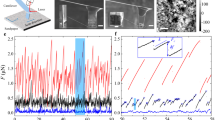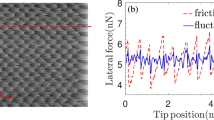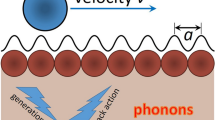Abstract
The phenomenon of sticking of one object to another, which drastically reduces their relative motion, is ubiquitous in nature. We have studied the sticking process of a colloid, suspended in a fluid medium by an optical tweezer, to a rigid substrate. The evolution of the frictional coupling between the two as a function of their separation is detected by the diffusivity of the particle and also by its phase-sensitive response to an in-plane external oscillatory drive applied to the substrate. On contact, the coupling changes abruptly from viscous to elastic for a rigid silica particle, whereas it evolves slowly with time, similar to ageing in glassy systems, for a soft and deformable polystyrene particle. Depending on the relative strengths of the particle–substrate interaction, the tweezer potential and the external drive, three regimes of dynamics—stuck, ageing and non-stuck—are observed in the dynamical phase diagram.
This is a preview of subscription content, access via your institution
Access options
Subscribe to this journal
Receive 12 print issues and online access
$209.00 per year
only $17.42 per issue
Buy this article
- Purchase on Springer Link
- Instant access to full article PDF
Prices may be subject to local taxes which are calculated during checkout






Similar content being viewed by others
References
Liu, A. & Nagel, S.R. Nonlinear dynamics: Jamming is not just cool anymore. Nature 396, 21–22 (1998).
Trappe, V., Prasad, V., Cipelletti, L., Segre, P. N. & Weitz, D. A. Jamming phase diagram for attractive particles. Nature 411, 772–775 (2001).
Bhattacharya, S. & Higgins, M. J. Dynamics of a disordered flux line lattice. Phys. Rev. Lett. 70, 2617–2620 (1993).
Giamarchi, T. & Bhattacharya, S. High Magnetic Fields: Applications in Condensed Matter Physics and Spectroscopy Vol. 595, 314–360 (Lecture Notes in Physics, Springer, 2002).
Reif, F. Fundamentals of Statistical and Thermal Physics Ch. 15 (McGraw-Hill, 1985).
Faxen, H. Die bewegung einer starren kugel längs der achse eines mit zährer flüssigkeit gefüllten rohres. Arkiv. Mat. Astron. Fys 17, 1–28 (1923).
Lin, B., Yu, J. & Rice, S. Direct measurements of constrained Brownian motion of an isolated sphere between two walls. Phys. Rev. E 62, 3909–3919 (2000).
Dufresne, E., Squires, T., Brenner, M. & Grier, D. Hydrodynamic coupling of two Brownian spheres to a planar surface. Phys. Rev. Lett. 85, 3317–3320 (2000).
Leheny, R. L. & Nagel, S. R. Frequency-domain study of physical ageing in a simple liquid. Phy. Rev. B 57, 5154–5162 (1998).
Behrens, S. H., Plewa, J. & Grier, D. G. Measuring a colloidal particle’s interaction with a flat surface under nonequilibrium conditions. Eur. Phys. J. E 10, 115–121 (2003).
Ghosh, S., Sharma, P. & Bhattacharya, S. Surface modes of a sessile water drop: An optical tweezer based study. Rev. Sci. Instrum. 78, 115110.1–115110.6 (2007).
Acknowledgements
We thank P. Chaikin, D. Dhar, D. Grier, M. W. Kim, S. Nagel, D. Pine and G. V. Shivashankar for helpful discussions.
Author information
Authors and Affiliations
Corresponding author
Supplementary information
Supplementary Information
Supplementary Informations (PDF 341 kb)
Rights and permissions
About this article
Cite this article
Sharma, P., Ghosh, S. & Bhattacharya, S. Microrheology of a sticking transition. Nature Phys 4, 960–966 (2008). https://doi.org/10.1038/nphys1105
Received:
Accepted:
Published:
Issue Date:
DOI: https://doi.org/10.1038/nphys1105
This article is cited by
-
Micro-rheology: A sticky problem
NPG Asia Materials (2009)



